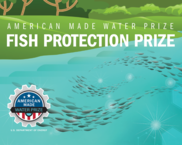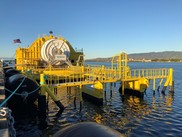WPTO, in collaboration with the Bureau of Reclamation, has announced the commencement of the Fish Protection Prize, inviting entrepreneurs and innovators to submit solutions to help address the challenge of protecting fish from water diversions and intakes. The competition will be organized through three consecutive stages—CONCEPT, INCUBATION, and PITCH—and will present contestants with the chance to win up to $700,000 of combined cash prizes and vouchers for research and facilities support from the National Laboratories and Reclamation. |
|
 |
Interested in joining the competition? Learn more about the timeline, requirements, and eligibility criteria here.
|
Incorporating marine energy into ocean observing technology could provide researchers with systems and instruments that last longer, cost less to power, offer better resolution and data collection, and help ensure a successful mission both above and beneath the waves.
WPTO and the National Oceanographic and Atmospheric Administration have teamed up to inspire innovators to make these benefits a reality through the Powering the Blue Economy™: Ocean Observing Prize.
|
|
 |
Sandia National Laboratories (Sandia) has completed a multi-year DOE-funded project to examine the effects of control theory on increasing power produced by wave energy conversion (WEC) devices. Resulting from a series of tank tests at the Naval Surface Warfare Center (Carderock Division) Maneuvering and Sea Keeping Basin in Bethesda, Maryland, Sandia has produced a report summarizing a range of WEC control experiments including mechanical vs. electrical power, predictionless control, self-tuning control, and more. As a way of disseminating some of the methods developed for testing, a set of MATLAB and Simulink files have also been released for public analysis and use that can be found here.
Sandia National Laboratories (Sandia), the Pacific Marine Energy Center (PMEC), and Oregon State University (OSU) will host an integrated wave energy converter (WEC) design workshop at OSU on February 3-4, 2020. During this two-day workshop, participants will work with Sandia and PMEC researchers to develop a hands-on understanding of WEC design theory and experimental testing approaches with a focus on dynamics, control signal processing, experimental design and analysis, and full-scale design.
The course will include classroom time as well as experimental wave tank testing of a model-scale WEC device at OSU’s Hinsdale Wave Basin. Graduate students, early stage career researchers, and/or research scientists with experience or interest in wave energy conversion are encouraged to attend.
The National Renewable Energy Laboratory recently caught up with winners of the Furthering Advancements to Shorten Time (FAST) Commissioning for Pumped-Storage Hydropower Prize. Since October 2019 when the winners were selected, they have continued to pursue their own approaches to shortening the time, cost, and risk associated with commissioning pumped-storage hydropower. Find out more about their progress here.
A collaboration between WPTO, seven other DOE offices, and the National Renewable Energy Laboratory has produced the State and Local Planning for Energy (SLOPE) Platform. Designed as an easy-to-access online tool for state and local decision makers, SLOPE enables data-driven planning by integrating dozens of distinct sources of energy efficiency, renewable energy, and sustainable transportation data and analyses. Access the SLOPE Platform Beta and download the overview fact sheet to learn more.
Staff from WPTO and the National Laboratories will be joined by environmental specialists, utility operators, hydropower plant managers, legal and permitting leads, policy analysts, and more at the Northwest Hydroelectric Association Annual Conference in Seattle, Washington. Taking place from February 18-21, the conference will provide a deep dive into the current communications behind hydropower, renewable portfolio standards, policy changes, incorporation of variable renewable energy sources into the grid, and other topics particularly relevant to the Pacific Northwest.
On February 18, WPTO will also be hosting a complimentary HydroWIRES workshop which will provide new details on the initiative and will include an interactive breakout session featuring National Lab work-in-progress to describe the linkages between environmental outcomes, flow decisions, and grid outcomes. Register for the conference and workshop here.
In Case You Missed It
The Waves to Water Prize is a 4-Stage, $2.5M contest to accelerate technology innovation in wave energy powered desalination systems. These technologies hold the potential to deliver clean water to communities for disaster relief purposes, and to remote communities throughout the globe. Enter now for your chance to win! A modification to the rules document was made on January 28, 2020.
Find out more about the current stage of the competition, the structure of the program at large, and the different stages here.
DOE selected 48 recipients for the $6.6 million FY2019 round of funding for the Hydroelectric Production Program under section 242 of the Energy Policy Act of 2005. Qualified facilities were selected based on the number of kilowatt hours generated by the facility in calendar year 2018. The Hydroelectric Production Incentive Program provides funding for projects adding hydroelectric power generating capabilities to existing dams throughout the United States.
Visit WPTO’s EPACT 242 funding page to view the FY2019 selectees.
On December 10, 2019 the WPTO-funded OceanEnergy Buoy arrived at Pearl Harbor, Hawaii for a ribbon cutting ceremony prior to deployment at the Wave Energy Test Site (WETS) off the coast of O’ahu. The buoy’s 35-meter, 826-ton hull, was fabricated throughout 2019 by Oregon-based Vigor, a ship building and maintenance company that designs, tests, and constructs navy stealth boats, combat ships, barges, and more. In parallel, Siemens Government Technologies and Vigor assembled the Hydro-Air self-rectifying air turbine and generator power take-off system. |
|
 |
Over the course of the next year, both turbine and buoy performance will be measured at WETS on a grid-connected scale never before seen in the United States. The test results will confirm the large-scale commercial viability of the technologies and provide confidence to move forward with commercialization efforts.
|